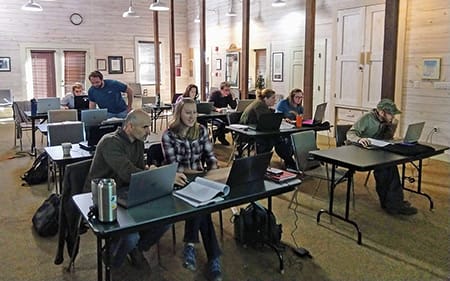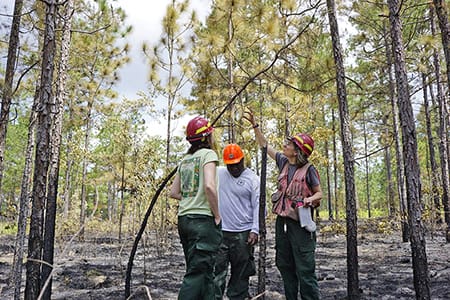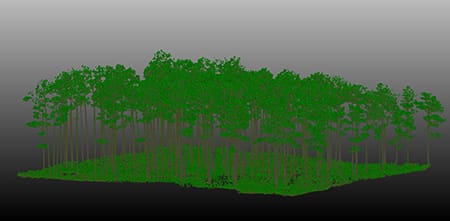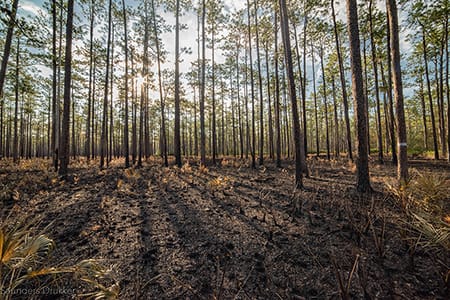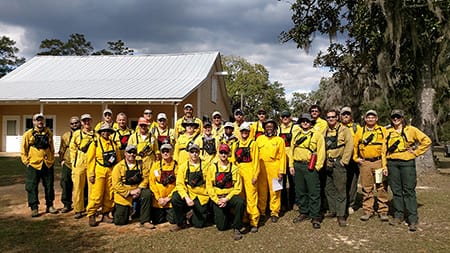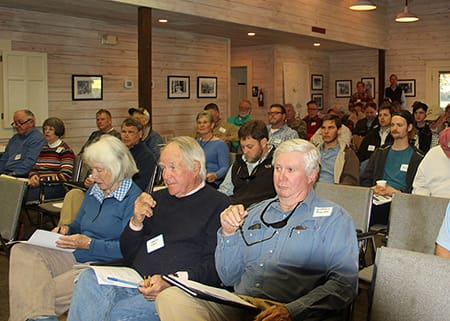Forestry research can often be a tedious task.
In the case of a multi-year study into the shortleaf pine, the work has involved tagging and tracking the growth of 225 individual saplings.
The study aims to fill in gaps in knowledge about the species’ life history and its unique fire-adapted traits that have often been overlooked from a management perspective.
Tall Timbers fire researcher Erin Wachter has been tagging and monitoring shortleaf pine in a unique section of the property called the Scrub Course. She continues the work of former Tall Timbers post-doctoral researcher Timothy Shearman, PhD., who is now a professor at Auburn University.
Found on the northern part of Tall Timbers, the Scrub Course is a remnant shortleaf pine-oak-hickory ecosystem, a plant community characterized by an open canopy of shortleaf pine and upland fire-loving hardwood trees such as mockernut hickory, post oak, southern red oak, white oak, and black oak.
Regionally less well known than the longleaf pine-wiregrass community, the shortleaf-oak-hickory community shares similar native groundcover characteristics and once occupied large swaths of the Red Hills. Shortleafs themselves also provide a highly flammable needle cast that is similar to longleaf, making an excellent fuel source for prescribed fire.
Started in 2022, the project now led by Wachter, looks at the effect regular fire intervals have on the resprouting of fire adapted shortleaf pine trees. She’s measuring how many resprouts each individual has and then also measuring the height and following any changes or tree mortality over time.
It’s a novel research project studying a plant community there is little detailed information about. The results may prove valuable when applied in land management that has focused on longleaf pine for the past few decades.
In the past five years, the individual saplings have been monitored immediately post fire, and then at intervals from three weeks to seven months. Of the original 225 saplings, about 75 have died since the start of the study.
The most resprouts recorded was 187 but the average per tree following a fire is 20-30. The thought, Wachter said, was that the multi-resprout adaptation gives the shortleaf a chance to have at least one of the sprouts grow rapidly enough to escape being killed in the next fire and grow into a tree.
Seeing which trees live through a fire and grow becomes an interesting story with such a large data set, Wachter said.
“It gets stuck in this cycle of resprouting and getting top killed by fire, and then resprouting and top killed by fire,” she said. “One of the things that we were really trying to do is figure out is how does it get out of that? What needs to happen?
“It’s fun to watch them all grow every time and be like, are you going to survive this time or not?”
Tall Timbers Research Director Morgan Varner said the shortleaf is often seen as an old field species, appearing in areas that were once heavily farmed for agriculture.
Instead, it is a fire-adapted species with unique traits that is a species of concern declining across its native range from New Jersey, to the Ozarks. Only a small portion of its range extends into Florida in the Red Hills region.
Varner called it one of the few “Swiss Army” pine species, able to thrive through a multitude of conditions, provide valuable habitat for threatened species like the Red-Cockaded Woodpecker, has an economic value as timber and can replace aging stands of common pines like loblolly that are relatively intolerant of fire.
“They do it all,” he said. “They are fire-resistant as a seedling. They’re fire-resistant as an adult. They can resprout from the crown and branches. They can resprout from the base. They’re using all the different strategies at once. It’s incredibly flexible from a management perspective.”
Over the past few decades, there has been a focus on reestablishing longleaf pine trees throughout their historic range. Landowners have responded by planting millions of longleaf seedlings from Virginia to Texas in an effort to not only improve wildlife habitat but the effectiveness of their management using prescribed fire.
But, seedlings cost money and longleaf take much longer to grow into mature trees, despite their fire-resistance even in their first year of life.
The research at Tall Timbers is looking at how shortleaf, which can often already be found on properties being knocked back by the typically two-year fire return, can be managed to help them grow into mature trees.
There are plans to plant them in research plots and introduce prescribed fire at differing intervals to see which fosters the best growth while also maintaining the shrubby understory for wildlife.
That type of research could provide some insight into how to better manage for them and encourage natural regeneration of this important fire-adapted species.
“The trees that are out there now are old. They’re going to die. We need something to replace them,” Wachter said. “And so, if we could do that naturally, rather than having to plant trees, that makes the most sense. We’re just starting to see a push more towards shortleaf and making sure that it stays on the landscape.”








